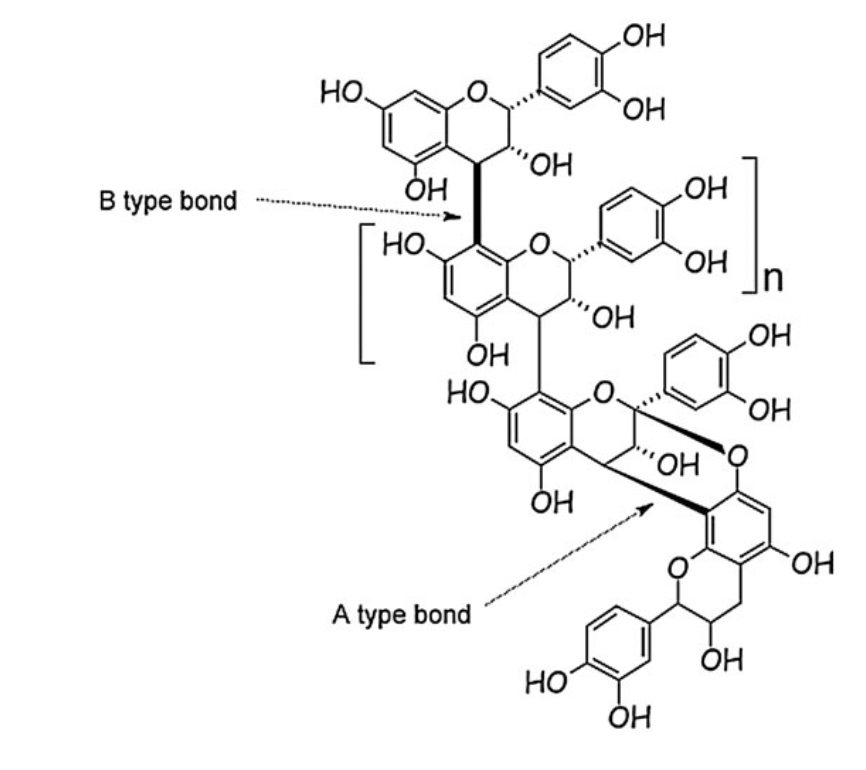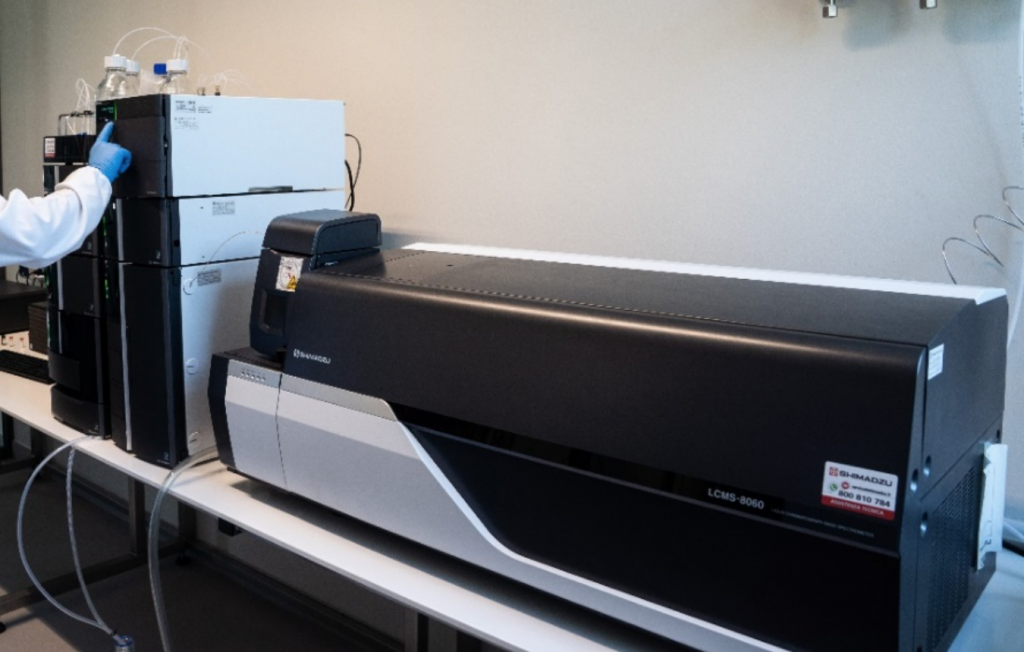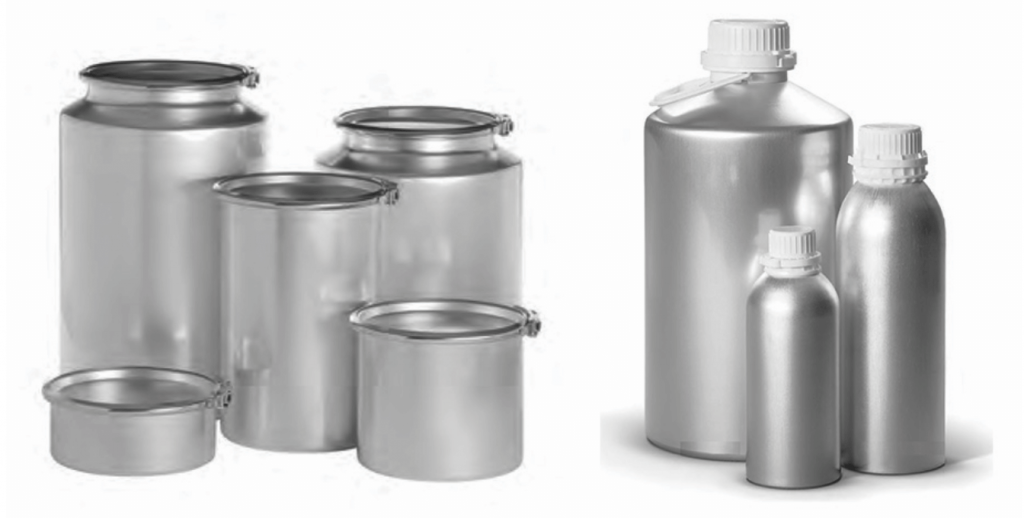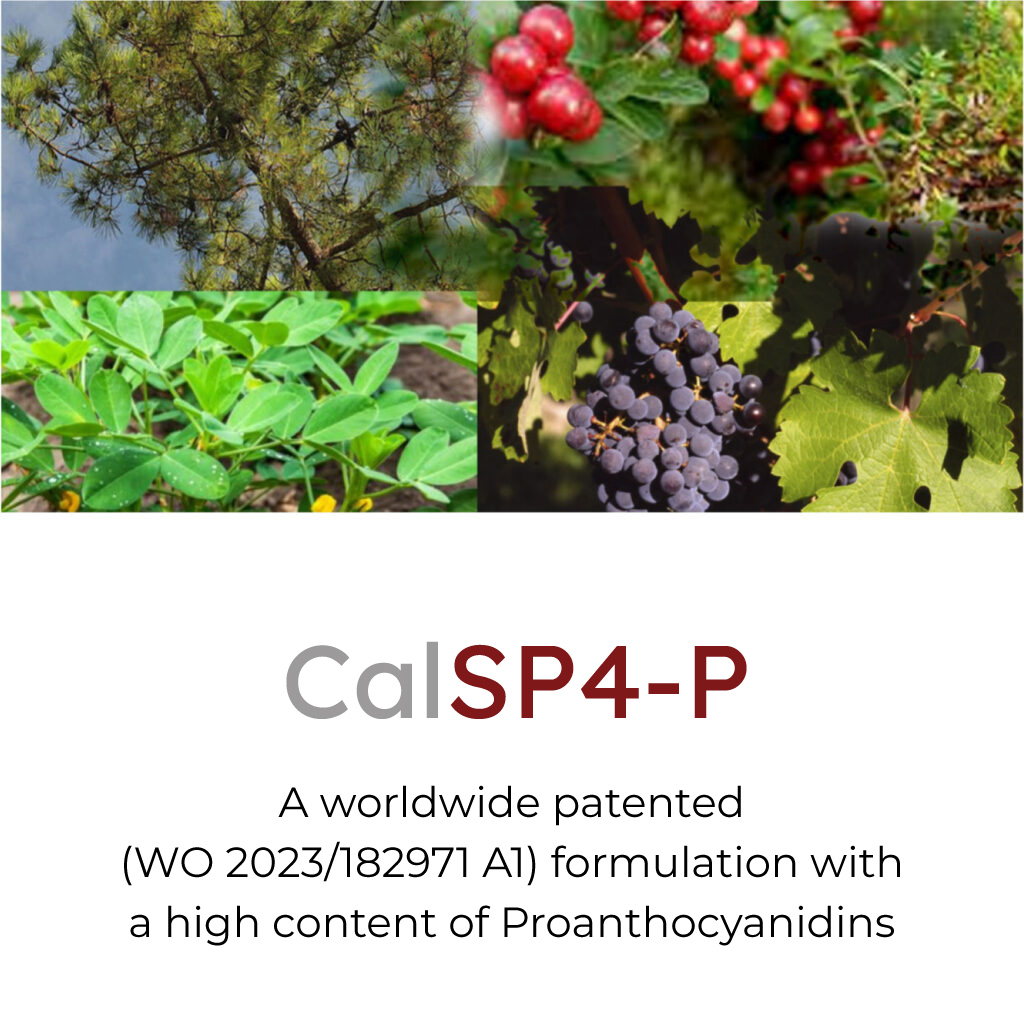
A worldwide patented formulation (WO 2023/182971 A1) based on Pinus pinaster, Vitis vinifera, Arachis hypogaea and Vaccinium vitis-idaea with the highest standardized content of proanthocyanidins (370-800 g/kg) on the market.
Proanthocyanidins are the main bioactive molecules of CalSP4
The health-promoting potential of several plants is associated with their antioxidant, antibacterial and antiviral activity resulting from the presence of proanthocyanidins (PACs). PACs are polymeric flavonoids known for their high free radical scavenging capacity.
PACs are characteized by two types of bonds: A-type and B-type, with A-Type bonds exerting the typical biological activity.

SCIENTIFIC EVIDENCE OF CALSP4 PROPERTIES
Recent publications investigated the metabolomics and antioxidant capacity of SP4TM, a patented formulation and extraction procedure based on a mixture of plant extracts with a high content of bioactive PACs and other polyphenols (Mannino and Maffei, 2022) [https://www.mdpi.com/2076-3921/11/7/1234].
HPLC-ESI-MS/MS analyses revealed the presence of 5 flavanols, 11 flavonols, and 8 anthocyans (both as aglycone and glycosylated form).
MALDI-TOF MS studies showed that SP4TM contains PACs with one or more A-type interflavan bonds at each degree of polymerization.
LUCS TECHNOLOGY performedon HepG2 cells, showed the ability of SP4TM to neutralize intracellular free radicals, inhibit membrane lipid peroxidation, quench H2O2, and reduce free radicals mainly through chelating mechanism, as demonstrated by a higher FRAP value compared with ABTS and DPPH. The antioxidant activity of SP4TM is twice as much that of resveratrol and over 20 times that of epicatechin. SP4TM has been shown to neutralize not only free radicals but also non-radical reactive oxygen species thus preventing and counteracting an excessive peroxidation of cell membrane lipids.
ANTI-ADHESION ACTIVITY showed that the SP4TM A-type PAC content strongly prevented bacterial adhesion of P-fimbriated uropathogenic Escherichia coli. Results showed that the final concentration at which anti-adhesion activity could be detected in SP4TM was 0.23 mg/mL. The value of 0.23 mg/mL is consistent with results obtained from other juice-based column-extracted cranberry powders tested. A direct comparison with organic cranberry juice powder (30 mg/mL), high PAC level cranberry extracts (0.47 mg/mL), low PAC level cranberry extracts (3.5-7.5 mg/mL), bacterial anti-adhesion activity of the commercial cranberry powder (measured by MRHA activity, 0.47 mg/mL) (Howell et al. 2015; Kaspar et al. 2015; Liu et al. 2019) and some fruit extracts of chosen Rosaceae family species (20-80 mg/mL) (Hendrich et al. 2020) indicates that SP4TM, with 0.23 mg/mL possesses the highest antiadhesion activity towards uropathogenic P-fimbriated E. coli on the market.
PRE-CLINICAL DOUBLE-BLIND CONTROLLED STUDY on the treatment of Urinary Tract Infection with the patented formulation (analysed by the Local Health Authority of the Piedmont Region – Italy – and by the National Health Service of the Piedmont Region – Italy) show that the administration of the SP4TM formulation significantly ameliorated UTI in the treatment group.
ANTIVIRAL ACTIVITY The appearance of new respiratory virus infections in humans with epidemic or pandemic potential has underscored the urgent need for effective broad-spectrum antivirals (BSAs). Bioactive compounds derived from plants may provide a natural source of new BSA candidates. CalSP4 was demonstrated to be a candidate direct-acting BSA against major current human respiratory viruses. CalSP4 inhibited the in vitro replication of SARS-CoV-2, hCoV-OC43, hCoV-229E, Influenza A and B viruses and Respiratory Syncytial Virus, in the low-microgram range.
CalSP4 and its PAC-A-rich fraction prevent respiratory viruses from attaching to target cells and exert virucidal activity. With Covid-19 this occurred through their interaction with the spike protein, thereby interfering with spike functions and leading to the loss of virions infectivity. Overall, these findings show that CalSP4 is a candidate BSA of natural origin for the prevention of human respiratory virus infections (Sibille et al., 2024) [https://www.mdpi.com/1422-0067/25/13/7370].

CalSP4 inhibits the replication of major human respiratory viruses.
ALLERGEN CONTENT of peanut allergens in the formulation SP4TM is determined by two analytical methods: ELISA and DNA. ELISA test shows that the dose of allergens in 600 mg product is about 1.5 µg, that is 1,000 times lower than the suggested threshold limits, whereas the DNA-Real-time PCR for the direct, qualitative detection and differentiation of specific Peanut (Arachis hypogaea) DNA sequences according to directive (EC) 1169/2011, shows that the dose of allergens in 600 mg product is about 0.6 µg, that is about 2,500 times lower than the suggested threshold limits.
SP4 has a strong antioxidant capacity involving multitarget mechanisms and is a potential supplement to fight urinary tract and viral infections due to its ability to inhibit uropathogenic E. coli adhesion and to bind to viral coatings thus preventing cell infection.
For this reason Calliero S.p.A. has obtained the exclusive licensing for Italy, France, Germany, Switzerland and Spain to use an innovative extraction patented method to obtain a powder extract with the highest PACs content on the market. This extract is the result of innovative extraction techniques that allow to standardize the PACs extracted from medicinal plants and to reach PACs values never obtained before.
ANALYTICAL TECHNIQUES
The identification and quantification of the bioactive PACs (with particular reference to Type-A PACs) and other phenolic compounds present in CalSP4 is carried out using liquid chromatography combined with mass spectrometry. In particular, molecules are characterized by UHPLC-DAD-FLD-ESI coupled to mass spectrometry using a very high resolution triple quadrupole. The search for pesticides and toxins is carried out in house by both UHPLC-ESI-Triple Quadrupole Mass Spectrometry and GC-MS triple quadrupole mass spectrometry on each single batch. The possible presence of allergens is searched for with biochemical (ELISA) and biomolecular (DNA qPCR) techniques.

EXTRACTION TECHNIQUES AND PRODUCTION CAPACITY
Pinus pinaster, Vitis vinifera, Arachis hypogaea and Vaccinium vitis-idaea are processed with an extractor with a capacity of 1500 kg. The yield in extract is 800 kg/day. On an annual basis, the production capacity is several tons and is carried out entirely by Calliero S.p.A. in the Moretta (CN) Italy plant. By using the international patent specifications, Calliero S.p.A. produces three levels of PACs concentrations:
CalSP4-P A formulation with a standardized total PAC content of 370 g/kg
CalSP4-PA A formulation with a standardized total PAC content of 550 g/kg
CalSP4-PC A formulation with a standardized total PAC content of 800 g/kg
The patent specifications exclusively licensed to Calliero S.p.A. allow to obtain a standardized powder extract with the highest PACs content on the market at an unbeatable price.
PROPERTIES OF PACS
Type-A PACs (PAC-A) are not only present in the American cranberry, instead they are present in several other plant species. They have the potential function in the prevention of prostatic cells oxidative stress damage (Yan et al. 2021), and exert antimicrobial activities because of both anti-adhesive activity (Mathison et al. 2014; Nabavi et al. 2017) and anti-aging effects via regulating in vivo redox state (Jiao et al. 2017). PAC-A also show a powerful radical scavenging in vitro activity (Maldonado et al. 2005) and a high antioxidant capacity (confirmed by DPPH, TEAC and ORAC methods) as well as antimicrobial activities against gram-positive bacterial strains and Candida albicans (Martins et al. 2020). PAC-A alleviate the symptoms of ulcerative colitis by regulating gut microbiota and metabolism (Huang et al. 2022), and protect the retina from light exposure damage by inhibiting oxidative stress and apoptotic mechanisms (Ishihara et al. 2018).
Both A- and B-type PACs show modulation of oxidative stress by a strong inhibitory effect on the murine tyrosinase and melanin synthesis (Kim and Yokozawa 2009), increase the antioxidant enzymes activity and inhibit pro-apoptotic genes expression in granulosa cells (Li et al. 2017), rescued cognitive impairment accompanied by suppressed oxidative stress and inflammatory stress in brain regions (Chen and Hu 2017), play an important role in controlling the antioxidant response of lung cancer cells via the Nrf2-ARE pathway (Sun et al. 2017), have a protective role in the abatement of doxorubicin-induced mutagenesis and cell proliferation changes (Attia et al. 2010), have promising potential to preserve retinal tissue functions via regulating oxidative stress and mitochondrial functions (Li et al. 2020), and reverse the mRNA and protein expression of apoptosis-associated genes (Rajput et al. 2019).
The bioactivity of CalSP4-P formulations is directly proportional to the content of PACs. For this reason Calliero S.p.A. obtained the license to use a patent that allows obtaining the only formulation available with the highest standardized PACs content on the market. The large-scale industrial process and innovative technologies make it possible to obtain products at highly competitive costs, guaranteeing a high level of purity and safety associated with an unbeatable quality/price ratio.
CLAIMS OF THE SPECIES COMPOSING CALSP4
Vaccinium Vitis-Idaea L.: Drainage of body fluids. Function of the urinary tract. Regularity of intestinal transit. Antioxidant.
Pinus pinaster L.: Antioxidant.
Vitis vinifera L.: Functionality of the microcirculation (heaviness of the legs). Antioxidant. Regular functionality of the cardiovascular system. Integrity and functionality of cell membranes. Trophism and functionality of the skin. Contrast of menstrual cycle disorders. Joint function.
PACKAGING
All products are delivered in high quality aluminum containers especially designed for packaging, transport and storage of value products. The containers are made of 1050A grade Aluminum with inner coating and available in sizes from 2 Kg to 25 Kg for powders and from 50 gr to 25 Kg for liquids. These containers not only guarantee an optimal tightness, but also a high level of chemical, microbiological and particle cleanliness.
Our delivery system is based on three main concepts:
Safety: Secured transport with a lever lock ring closure, nitrile (or silicone) gasket and an aluminum lid for powders and PP cap with tamper evident tear off ratchet ring and PE plug with tear off ring for liquids; high resistance and tightness even when exposed to high pressure differences; compatible with anti-tamper seals; no residue after use; excellent mechanical resistance against shocks, perforations and compressions caused during transport. Moreover, they are compliant to the European standard regulation for food contact.
User friendly: Easy to use and to empty with a 220 mm (8.66 in) wide open top for powders and from 22 mm to 46 mm (0.9 to 1.8 in) bottle neck for liquids; easily washable and sterilizable. The liquid containers allow precise drop, easy pouring and a standard closure. Bottles from 1 to 25 Kg are equipped with a rotating handle that helps to manipulate the bottles.
Environmentally friendly: 100% recyclable high scrap value aluminum monoblock.

Chen Q, Hu PP (2017) Proanthocyanidins prevent ethanol-induced cognitive impairment by suppressing oxidative and inflammatory stress in adult rat brain. Neuroreport 28 (15):980-986. doi:10.1097/wnr.0000000000000867
Hendrich AB, Strugala P, Dudra A, Kucharska AZ, Sokol-Letowska A, Wojnicz D, Cisowska A, Sroka Z, Gabrielska J (2020) Microbiological, antioxidant and lipoxygenase-1 inhibitory activities of fruit extracts of chosen Rosaceae family species. Adv Clin Exp Med 29 (2):215-224. doi:10.17219/acem/115086
Howell A, Souza D, Roller M, Fromentin E (2015) Comparison of the Anti-Adhesion Activity of Three Different Cranberry Extracts on Uropathogenic P-fimbriated Escherichia coli: a Randomized, Double-blind, Placebo Controlled, Ex Vivo, Acute Study. Nat Prod Commun 10 (7):1215-1218
Huang B, Wang L, Liu M, Wu X, Lu Q, Liu R (2022) The underlying mechanism of A-type procyanidins from peanut skin on DSS-induced ulcerative colitis mice by regulating gut microbiota and metabolism. J Food Biochem:e14103. doi:10.1111/jfbc.14103
Ishihara T, Kaidzu S, Kimura H, Koyama Y, Matsuoka Y, Ohira A (2018) Protective Effect of Highly Polymeric A-Type Proanthocyanidins from Seed Shells of Japanese Horse Chestnut (Aesculus turbinata BLUME) against Light-Induced Oxidative Damage in Rat Retina. Nutrients 10 (5):14. doi:10.3390/nu10050593
Jiao JJ, Wei Y, Chen JN, Chen XY, Zhang Y (2017) Anti-aging and redox state regulation effects of A-type proanthocyanidins-rich cranberry concentrate and its comparison with grape seed extract in mice. J Funct Food 30:63-73. doi:10.1016/j.jff.2016.12.039
Kaspar KL, Howell AB, Khoo C (2015) A randomized, double-blind, placebo-controlled trial to assess the bacterial anti-adhesion effects of cranberry extract beverages. Food Funct 6 (4):1212-1217. doi:10.1039/c4fo01018c
Kim YJ, Yokozawa T (2009) Modulation of Oxidative Stress and Melanogenesis by Proanthocyanidins. Biol Pharm Bull 32 (7):1155-1159. doi:10.1248/bpb.32.1155
Li BJ, Weng QN, Liu ZQ, Shen M, Zhang JQ, Wu WJ, Liu HL (2017) Selection of antioxidants against ovarian oxidative stress in mouse model. J Biochem Mol Toxicol 31 (12):6. doi:10.1002/jbt.21997
Li LL, Geng X, Tian LL, Wang DB, Wang Q (2020) Grape seed proanthocyanidins protect retinal ganglion cells by inhibiting oxidative stress and mitochondrial alteration. Arch Pharm Res 43 (10):1056-1066. doi:10.1007/s12272-020-01272-9
Liu HY, Howell AB, Zhang DJ, Khoo C (2019) A randomized, double-blind, placebo-controlled pilot study to assess bacterial anti-adhesive activity in human urine following consumption of a cranberry supplement. Food Funct 10 (12):7645-7652. doi:10.1039/c9fo01198f
Maldonado PD, Rivero-Cruz I, Mata R, Pedraza-Chaverri J (2005) Antioxidant activity of A-type proanthocyanidins from Geranium niveum (Geraniaceae). J Agric Food Chem 53 (6):1996-2001. doi:10.1021/jf0483725
Mannino G, Maffei ME (2022) Metabolomics-Based Profiling, Antioxidant Power, and Uropathogenic Bacterial Anti-Adhesion Activity of SP4TM, a Formulation with a High Content of Type-A Proanthocyanidins. Antioxidants 11 (7):1234
Martins GR, do Amaral FRL, Brum FL, Mohana-Borges R, de Moura SST, Ferreira FA, Sangenito LS, Santos ALS, Figueiredo NG, da Silva AS (2020) Chemical characterization, antioxidant and antimicrobial activities of acai seed (Euterpe oleracea Mart.) extracts containing A- and B-type procyanidins. LWT-Food Sci Technol 132:11. doi:10.1016/j.lwt.2020.109830
Mathison BD, Kimble LL, Kaspar KL, Khoo C, Chew BP (2014) Consumption of cranberry beverage improved endogenous antioxidant status and protected against bacteria adhesion in healthy humans: a randomized controlled trial. Nutr Res 34 (5):420-427. doi:10.1016/j.nutres.2014.03.006
Nabavi SF, Sureda A, Daglia M, Izadi M, Nabavi SM (2017) Cranberry for Urinary Tract Infection: From Bench to Bedside. Curr Top Med Chem 17 (3):331-339. doi:10.2174/1568026616666160829161031
Rajput SA, Zhang C, Feng Y, Wei XT, Khalil MM, Rajput IR, Baloch DM, Shaukat A, Rajput N, Qamar H, Hassan M, Qi DS (2019) Proanthocyanidins Alleviates AflatoxinB(1)-Induced Oxidative Stress and Apoptosis through Mitochondrial Pathway in the Bursa of Fabricius of Broilers. Toxins 11 (3):13. doi:10.3390/toxins11030157
Sun C, Jin WG, Shi HC (2017) Oligomeric proanthocyanidins protects A549 cells against H2O2-induced oxidative stress via the Nrf2-ARE pathway. Int J Mol Med 39 (6):1548-1554. doi:10.3892/ijmm.2017.2971
Yan FF, Chen L, Chen WB, Zhao L, Lu Q, Liu R (2021) Protective effect of procyanidin A-type dimers against H2O2-induced oxidative stress in prostate DU145 cells through the MAPKs signaling pathway. Life Sci 266:11. doi:10.1016/j.lfs.2020.118908
